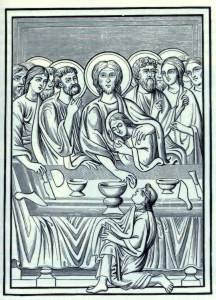| The
sacrament associating Christ's body and blood with bread and wine;
object of intense controversy during the era of reform. |
 |
|
11th-century
representation
of Holy Communion
|
Roman
Catholic, Reformed, Lutheran, Radical, and Anglican theologians differed
considerably over the Holy Communion during the era of reform.The
theology and practice of the English Protestant reformers seems largely
to have been derived from the Reformed pattern.
Roman Catholic:
At the Council of Trent
(1545-1563) the Roman Catholic Church reiterated the position on the
Holy Communion it had defined and refined during the middle ages.
Three positions in particular had become controversial during the
era of reform. First, the Roman Catholic Church taught that the mass
is a sacrifice during which Christ sacrifices himself to God the Father
bloodlessly under the signs of bread and wine. This sacrifice is intended
to represent the sacrifice of the cross to the congregation and apply
its saving power to them. Second, employing a distinction borrowed
from Aristotle and put to Christian use by medieval theologians, the
Roman Catholic Church taught the doctrine of transubstantiation,
according to which the "accidents" of bread and wine, the things determining
its appearance and the human perception thereof, remained that of
bread and wine, while its "substance," the internal nature of bread
and wine, became Christ's body and blood. Third, Roman Catholic practice
withheld the cup from the laity who were permitted to receive only
the bread.
Protestants consistently
rejected both the sacrifice of the mass and the doctrine of transubstantiation.
Protestants also consistently maintained the privilege of the laity
to receive both bread and wine in the Holy Communion.
Lutheran:
Martin Luther's understanding
of the Holy Communion went through several phases. As his teaching
developed, Luther taught that the Holy Communion was not a sacrifice
but the last will and testament of Jesus, a promise, in which he bequeathed
to believers the forgiveness of sins secured by his death on the cross.
For Luther, this trustworthy promise could be met by either faith
or unbelief. Although repudiating transubstantiation as a philosophical
invention unworthy of Christian theology, Luther laid great weight
on the real presence of Christ in the Holy Communion, claiming that
Christ's body and blood were eaten and drunk by believers and unbelievers
alike. Believers, he taught, ate and drank at the Lord's Supper to
their blessing, while unbelievers ate and drank to their own condemnation.
Reformed:
Huldrych Zwingli advanced
the first Reformed doctrine of the Holy Communion. Unlike Luther,
Zwingli thought of the elements or signs in the Lord's Supper not
as means by which God communicates grace to the faithful, but as signs
by which the faithful declare that they have received grace and belong
to the body of the faithful. For Zwingli the Holy Communion was essentially
a communal profession of faith, a celebrative thanksgiving in which
the church declared its gratitude and faithfulness to God. Later Reformed
theologians, including Martin Bucer, Heinrich Bullinger, and John
Calvin, sought a middle way between Luther's position and that
of Zwingli. Against Zwingli they argued that Christ was certainly
present in the signs of bread and wine, but against Luther they argued
that Christians could not rightly comprehend the mode of Christ's
presence. Like Luther, they considered the Holy Communion to be constituted
by Christ's promise and like Zwingli they thought that it rightly
included an element of eucharistic thanksgiving.
Radical:
Some theologians of the radical Reformation, including Sebastian
Franck and Kaspar von Schwenkfeld, abandoned altogether or suspended
the use of the Holy Communion. Others dramatically reinterpreted it.
Some radical theologians associated the elements of the Holy Communion
in various ways with Christ's heavenly body. More often, however,
they saw the Lord's Supper as an occasion to hold Christ's death in
grateful remembrance. The ideas of an egalitarian fellowship in the
sight of God and preparation for martyrdom often dominated the piety
of this faction of the Reformation.
English:
The teaching of Thomas Cranmer,
architect of the English Book of Common Prayer, regarding the
Holy Communion is a matter of considerable dispute as is the proper
interpretation of the doctrinal statements issued during the English
reformation. These standards of the English reformation seem clearly
to reject both the sacrifice of the mass and transubstantiation. In
the matter of Christ's presence, the Thirty-Nine
Articles appear to align the English reformation most closely
to the position of Martin Bucer, Heinrich Bullinger, and John Calvin.
They affirm a heavenly and spiritual presence of Christ in the Holy
Communion and consider it to be a means rather than merely a sign
of grace.
|
